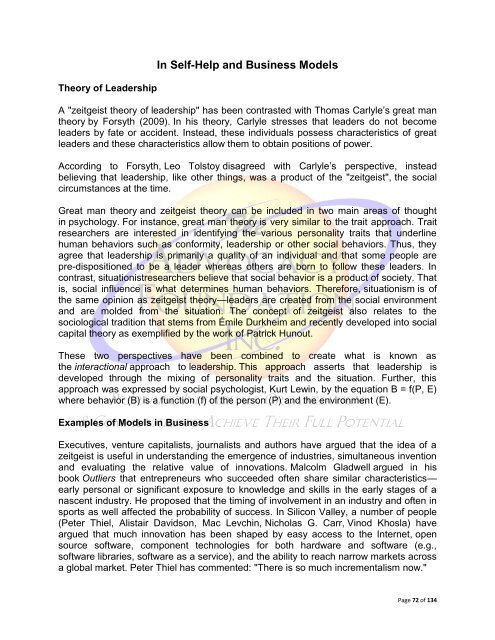Cultural Transformation
Cultural Transformation
Cultural Transformation
You also want an ePaper? Increase the reach of your titles
YUMPU automatically turns print PDFs into web optimized ePapers that Google loves.
Theory of Leadership<br />
In Self-Help and Business Models<br />
A "zeitgeist theory of leadership" has been contrasted with Thomas Carlyle’s great man<br />
theory by Forsyth (2009). In his theory, Carlyle stresses that leaders do not become<br />
leaders by fate or accident. Instead, these individuals possess characteristics of great<br />
leaders and these characteristics allow them to obtain positions of power.<br />
According to Forsyth, Leo Tolstoy disagreed with Carlyle’s perspective, instead<br />
believing that leadership, like other things, was a product of the "zeitgeist", the social<br />
circumstances at the time.<br />
Great man theory and zeitgeist theory can be included in two main areas of thought<br />
in psychology. For instance, great man theory is very similar to the trait approach. Trait<br />
researchers are interested in identifying the various personality traits that underline<br />
human behaviors such as conformity, leadership or other social behaviors. Thus, they<br />
agree that leadership is primarily a quality of an individual and that some people are<br />
pre-dispositioned to be a leader whereas others are born to follow these leaders. In<br />
contrast, situationistresearchers believe that social behavior is a product of society. That<br />
is, social influence is what determines human behaviors. Therefore, situationism is of<br />
the same opinion as zeitgeist theory—leaders are created from the social environment<br />
and are molded from the situation. The concept of zeitgeist also relates to the<br />
sociological tradition that stems from Émile Durkheim and recently developed into social<br />
capital theory as exemplified by the work of Patrick Hunout.<br />
These two perspectives have been combined to create what is known as<br />
the interactional approach to leadership. This approach asserts that leadership is<br />
developed through the mixing of personality traits and the situation. Further, this<br />
approach was expressed by social psychologist, Kurt Lewin, by the equation B = f(P, E)<br />
where behavior (B) is a function (f) of the person (P) and the environment (E).<br />
Examples of Models in Business<br />
Executives, venture capitalists, journalists and authors have argued that the idea of a<br />
zeitgeist is useful in understanding the emergence of industries, simultaneous invention<br />
and evaluating the relative value of innovations. Malcolm Gladwell argued in his<br />
book Outliers that entrepreneurs who succeeded often share similar characteristics—<br />
early personal or significant exposure to knowledge and skills in the early stages of a<br />
nascent industry. He proposed that the timing of involvement in an industry and often in<br />
sports as well affected the probability of success. In Silicon Valley, a number of people<br />
(Peter Thiel, Alistair Davidson, Mac Levchin, Nicholas G. Carr, Vinod Khosla) have<br />
argued that much innovation has been shaped by easy access to the Internet, open<br />
source software, component technologies for both hardware and software (e.g.,<br />
software libraries, software as a service), and the ability to reach narrow markets across<br />
a global market. Peter Thiel has commented: "There is so much incrementalism now."<br />
Page 72 of 134

















